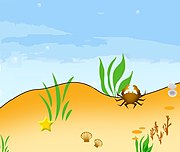
Back Fitobentos Azerbaijani Phytobenthos German Fütobentos Estonian Фитобентос Kazakh Фитобентос Kirghiz Fitobentos Polish Fitobentos Portuguese Фітобентос Ukrainian
| Part of a series related to |
| Benthic life |
|---|
 |
|
Benthos Benthic zone Benthopelagic (coupling) Seabed |

Phytobenthos (/.faɪtoʊˈbɛnθɒs/) (from Greek φυτόν (phyton, meaning "plants") and βένθος (benthos, meaning "depths") are autotrophic organisms found attached to bottom surfaces aquatic environments, such as rocks, sediments, or even other organisms.[1][2][3] This photosynthetic community includes single-celled or filamentous cyanobacteria, microalgae, and macrophytes.[4][5] Phytobenthos are highly diverse, and can be found in freshwater and marine environments, as well as transitional water systems.[6][7] However, their distribution and availability still depend on the factors and stressors that exist in the environment.[8] Because phytobenthos are autotrophs, they need to be able to subsist where it is still possible to perform photosynthesis.[1] Similar to phytoplankton, phytobenthos contribute to the aquatic food web for grazers and heterotrophic bacteria, and researchers have also been studying their health as an indicator for water quality and environmental integrity of aquatic ecosystems.[5][9][10][11][12][13]
- ^ a b Law, Rosemary J. (December 2011). "A Review of the Function and uses of, and Factors Affecting, Stream Phytobenthos". Freshwater Reviews. 4 (2): 135–166. doi:10.1608/FRJ-4.1.448. ISSN 1755-084X. S2CID 89974491.
- ^ Mora, Demetrio; Jung, Lea (2021-02-04). "Exploring new territories: sampling phytobenthos in large rivers". International Society for Diatom Research. Retrieved 2021-11-13.
- ^ Aponte, Nilda E.; Ballantine, David L. (October 2001). "Depth distribution of algal species on the deep insular fore reef at Lee Stocking Island, Bahamas". Deep Sea Research Part I: Oceanographic Research Papers. 48 (10): 2185–2194. Bibcode:2001DSRI...48.2185A. doi:10.1016/S0967-0637(01)00011-5.
- ^ Wilkinson, M. (2001), "Phytobenthos", Encyclopedia of Ocean Sciences, Elsevier, pp. 2172–2179, doi:10.1006/rwos.2001.0216, ISBN 978-0-12-227430-5, retrieved 2021-11-14
- ^ a b Schaumburg, Jochen; Schranz, Christine; Foerster, Julia; Gutowski, Antje; Hofmann, Gabriele; Meilinger, Petra; Schneider, Susanne; Schmedtje, Ursula (December 2004). "Ecological classification of macrophytes and phytobenthos for rivers in Germany according to the water framework directive". Limnologica. 34 (4): 283–301. doi:10.1016/s0075-9511(04)80002-1. ISSN 0075-9511.
- ^ Urbanič, Gorazd; Debeljak, Barbara; Kuhar, Urška; Germ, Mateja; Gaberščik, Alenka (2021-06-30). "Responses of Freshwater Diatoms and Macrophytes Rely on the Stressor Gradient Length across the River Systems". Water. 13 (13): 1814. doi:10.3390/w13131814. ISSN 2073-4441.
- ^ Petrocelli, Antonella; Cecere, Ester; Rubino, Fernando (2019-03-05). "Successions of phytobenthos species in a Mediterranean transitional water system: the importance of long term observations". Nature Conservation. 34: 217–246. doi:10.3897/natureconservation.34.30055. ISSN 1314-3301. S2CID 155161822.
- ^ L'Abée-Lund, Jan Henning; Haugland, Svein; Melvold, Kjetil; Saltveit, Svein Jakob; Eie, Jon Arne; Hvidsten, Nils Arne; Pettersen, Vegard; Faugli, Per Einar; Jensen, Arne J. (2009-01-01), Tockner, Klement; Uehlinger, Urs; Robinson, Christopher T. (eds.), "Chapter 15 - Rivers of the Boreal Uplands", Rivers of Europe, London: Academic Press, pp. 577–606, ISBN 978-0-12-369449-2, retrieved 2021-11-14
- ^ Kelly, Martyn (2013-11-01). "Data rich, information poor? Phytobenthos assessment and the Water Framework Directive". European Journal of Phycology. 48 (4): 437–450. doi:10.1080/09670262.2013.852694. ISSN 0967-0262. S2CID 84627104.
- ^ Schneider, Susanne C.; Hjermann, Dag O.; Edvardsen, Hanne (2019-05-01). "Do benthic algae provide important information over and above that provided by macrophytes and phytoplankton in lake status assessment? – Results from a case study in Norway". Limnologica. 76: 28–40. doi:10.1016/j.limno.2019.02.001. hdl:11250/2629019. ISSN 0075-9511. S2CID 109717021.
- ^ Schaumburg, Jochen; Schranz, Christine; Hofmann, Gabriele; Stelzer, Doris; Schneider, Susanne; Schmedtje, Ursula (2004-12-01). "Macrophytes and phytobenthos as indicators of ecological status in German lakes — a contribution to the implementation of the water framework directive". Limnologica. New methods for assessing freshwaters in Germany. 34 (4): 302–314. doi:10.1016/S0075-9511(04)80003-3. ISSN 0075-9511.
- ^ Bohórquez, Julio; McGenity, Terry J.; Papaspyrou, Sokratis; García-Robledo, Emilio; Corzo, Alfonso; Underwood, Graham J. C. (2017). "Different Types of Diatom-Derived Extracellular Polymeric Substances Drive Changes in Heterotrophic Bacterial Communities from Intertidal Sediments". Frontiers in Microbiology. 8: 245. doi:10.3389/fmicb.2017.00245. ISSN 1664-302X. PMC 5326797. PMID 28289404.
- ^ Bilous, Olena P.; Wojtal, Agata Z.; Ivanova, Natalia O.; Tsarenko, Petro M.; Burova, Olga V.; Barinova, Sophia (December 2020). "Benthic Diatom Composition in Coastal Zone of Black Sea, Sasyk Reservoir (Ukraine)". Diversity. 12 (12): 458. doi:10.3390/d12120458.
© MMXXIII Rich X Search. We shall prevail. All rights reserved. Rich X Search